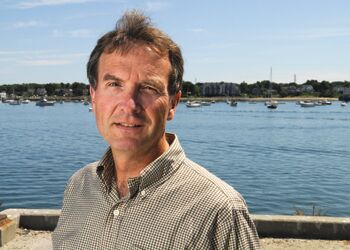Processing Your Payment
Please do not leave this page until complete. This can take a few moments.
- News
-
Editions
View Digital Editions
Biweekly Issues
- December 1, 2025
- Nov. 17, 2025
- November 03, 2025
- October 20, 2025
- October 6, 2025
- September 22, 2025
- + More
Special Editions
- Lists
- Viewpoints
-
Our Events
Event Info
Award Honorees
- Calendar
- Biz Marketplace
Energy futures | Renewables will get increasing attention as power providers assess Maine's needs
 Photo/David A. Rodgers
John Ferland, director of project development for tidal energy firm ORPC
Photo/David A. Rodgers
John Ferland, director of project development for tidal energy firm ORPC
Maine is slightly more than self-sufficient in electricity generation. The volume of electricity we export and lose in transmission is slightly greater than the volume we import. In 2008, what the U.S. Energy Information Administration calls the net trade index stood at 1.15, meaning we disposed of 15% more electricity than we generated, a 20-year trend. Given this long-standing fact, all the activity that has arisen over the past several years about building new electricity generation facilities derives from one of three sources: concern for the environmental effects of using fossil fuel, concern for the volatile and generally rising prices of fossil fuels and the desire to export more electricity. In this article, we’ll ask those involved to explain what they’re trying to do and assess the impacts of these efforts on the Maine economy.
Since 1999, Maine’s Public Utilities Commission has required that at least 30% of retail electricity sales come from renewable sources. In 2006, Maine set an additional goal to increase renewable energy capacity by 10% by 2017. This regulatory change, along with concern about global warming, the price volatility and security risks associated with fossil fuels and the increasing amounts of federal money available for research and installation, has produced a burst of interest in the generation of electricity from renewable sources. In Maine, this interest has taken two major forms — efforts to generate electricity from wind, tidal and solar power sources and Central Maine Power Co.’s recently approved proposal to improve the state’s transmission grid. Although there are many efforts to diminish energy use through efficiency and conservation, this article focuses on generation.
Wind
In Maine, half of the electricity we currently generate comes from renewable sources like hydropower and biomass. The effort to replace the other half, almost all of which is powered by natural gas, is being led by the on-shore wind energy industry. In fact, construction of on-shore wind turbines has already helped prop up the ailing construction industry. Jackson Parker, president of Reed & Reed in Wiscasset, a primary installer of large-scale wind projects in Maine and New England, notes, “In a time when many construction companies are stagnant, we’re seeing significant growth. And almost all of this is from wind power projects.”
But to continue this rapid growth, improving the competitive position of the industry compared to fossil fuel plants and other renewables will be important. “In New England, electricity from wind competes most directly with natural gas, and right now gas prices are pretty low,” says Matt Kearns, vice president of business development at Massachusetts-based First Wind. “Some projects that looked financially attractive two years ago, when gas prices were higher, aren’t as appealing at these prices.” The national average for natural gas sold to electric power generators peaked in June 2008, at $12.41 per thousand cubic feet, according to the EIA. A year later it had fallen 65% to $4.58. This past February, the most recent month available, it stood at $6.26 per thousand cubic feet.
One of the answers, Kearns says, is to find less expensive ways to manufacture turbines. “In order to do that, turbine manufacturers need to continually improve the technology to make turbines from lighter, more durable materials and find increasingly efficient ways to translate wind into power,” says Kearns.
Technological progress is important for offshore wind, too. Beth Nagusky, co-chair of the Governor’s Ocean Energy Task Force, says technology to draw affordable electric power from deep-water turbines is currently being developed and tested, and the high cost of trying can be a deterrent to investment. “We believe that costs of offshore wind will come down over time and with experience, while the price for oil and natural gas will most likely rise. But in the short term, and in the absence of a price on carbon, subsidies are needed to help the industry develop,” says Nagusky. In order to encourage more investment, the Legislature enacted ocean energy legislation directing Maine utilities to enter into long-term contracts with offshore ocean energy projects, even at above-market prices.
Grid
The cost of wind energy, though, is more than just the cost of turbines and blades. It also includes everything else needed to meet peak electricity demands when the wind isn’t blowing. A full build-out of wind requires an accompanying major investment in the power grid.
John Carroll, spokesman for Central Maine Power, says today’s electrical grid is outdated and, if wind is to be a major player in meeting our electricity needs, inadequate. Maine’s transmission system was created when Maine had a few large power generators, he says, and the current challenges to the grid are accentuated as renewable energy generation becomes more widespread.
The fate of the wind energy industry, both on shore and off, is intertwined with efforts to upgrade the power grid. Central Maine Power’s Maine Power Reliability Program, estimated to cost approximately $1.4 billion, was recently approved by the PUC. Carroll says the upgrade of the grid is necessary for three reasons: to buffer the enormous volatility inherent in the intermittency and volume differentials of wind power; to bring power from scattered and remote generation sources to the more centralized places of consumption; and to accommodate the export of volumes that could, at full build-out, mean a substantial increase in Maine’s electricity exports.
To proceed with its upgrade plan, CMP needs to convince a host of agencies and local governments that the plan is a good one. In addition to the PUC, the Army Corp of Engineers, Department of Environmental Protection and the Federal Energy Regulatory Commission must provide approvals. So must the 81 towns that the transmission lines go through. Carroll is confident, though, and says he has agreements with about half of the towns already and hopes to have the other half within a month or two. While the PUC did not approve CMP’s full request, it did OK the most significant portions of the transmission line upgrade.
Solar
Not everyone agrees that a major overhaul of the electrical grid is the way to go. Marc Isaacson, founding partner of GridSolar in Portland, has offered an alternative way to meet Maine’s need for more environmentally friendly and less expensive and volatile electricity. “Instead of multi-billion-dollar investments in power lines, both here in Maine and throughout New England, we can meet peak demand for electricity through vastly less expensive solar generation,” he says. Isaacson sees economic and market forces all pointing in the direction of less expensive distributed power systems like solar. “The cost of building new generation and transmission facilities and of borrowing the money to finance them is rising rapidly, while the cost of peak load management facilities is falling.”
Isaacson says that if Maine chooses to go this route, we could become home to solar development testing and to the investigation of smart grid monitoring, testing and evaluation systems. “If Maine took the lead in using solar as a substitute for expensive investments in transmission capacity,” he says, “solar research could become as important an industry here as biotechnology research.” While GridSolar will not provide a full alternative to the proposed transmission line upgrade, it will begin pilot projects to enable CMP to reduce the volume of new transmission line expenditures needed and thus save ratepayers a substantial sum in future rates. This may help keep Issacson’s dream of making Maine a hot bed of solar research alive.
Tidal
If wind and solar are two hares sprinting to the finish before the PUC, the tidal industry is the tortoise. “Our plan is to start small and work up gradually,” says John Ferland, director of project development for Ocean Renewable Power Co., which has embarked on a pilot program to create electricity from the tides of Cobscook Bay. Ferland thinks his project is the “Kittyhawk” of ocean power. “We get less publicity and controversy than wind development, but we’re going to be producing sooner,” he says.
By helping create and develop the on-shore support services needed for marine-based energy generation and finding the best ways to work with regulatory agencies on the siting process, Ferland says tidal energy is “blazing the trail of energy generation in a marine environment.” In addition, Ferland doesn’t see a large-scale investment in the grid as necessary to accept power from tidal generation. “We’re scalable and we’re growing slowly. As our size and number of locations increase, the transmission system will be able to grow with us.” Each tidal energy site is unique, he says, requireing unique technological, environmental and community adjustments to make it feasible.
What is needed for all sites, however, is continued financing. “(Maine Technology Institute) has been very supportive financially and very efficient in its program operation,” says Ferland. While the $1.3 million MTI has provided “isn’t big on a national scale, it has been absolutely critical to us as seed money enabling us to obtain other financing.”
Siting
While most Mainers agree in general that increasing the generation of power from non-carbon-based sources is a laudable goal, their support does not translate from the general to the specific. All of the business leaders we spoke to said that siting wind turbines, transmission lines and arrays of tidal turbines is the major challenge to the goal of generating more electricity from renewable sources.
For wind, the challenges lie more with local siting regulation. Reed & Reed’s Parker says convincing the public of the benefits of wind power is critical for continuation of its rapid growth. “In the past, the industry thought if it met the environmental permitting standards that would be enough. We know now that we have to get our story out there in the court of public opinion too,” he says. Beth Nagusky notes that wind and tidal energy don’t yet directly affect heating and transportation costs. Until they do, the benefits are harder to see. “When people start to see wind and other renewable energy sources replace heat and gasoline, public acceptance will get better,” she says.
Generating utility-scale electricity from wind, solar or tidal energy, with or without improvements to the power grid, is just a first step toward reducing energy costs in Maine. For Maine people to fully realize those benefits, there must be ways to use this electricity not just for lights, but for home heating and transportation needs. “The real transformation of energy costs involves ‘electrifying’ our transportation and heating infrastructure, using clean renewable energy as the generating source,” says Nagusky. Since 90% of a typical household’s energy budget is for heating and transportation, this means transitioning to more efficient electric heat sources and electric vehicles. This will not happen overnight. But, it is technologically feasible, and with the right policies, realization of the vision is possible.
Michael LeVert, Maine state economist, and Chuck Lawton, chief economist with Planning Decisions, a South Portland-based consulting firm, are collaborating on Working Knowledge, a six-part series exploring what Maine’s biggest industries need to prosper. Part VI is the wrap-up.
PART I: Setting the stage
PART II: Paper goods
PART III: Rx for growth
PART IV: Without reservation
Mainebiz web partners

The Giving Guide
The Giving Guide helps nonprofits have the opportunity to showcase and differentiate their organizations so that businesses better understand how they can contribute to a nonprofit’s mission and work.
Learn More
Work for ME
Work for ME is a workforce development tool to help Maine’s employers target Maine’s emerging workforce. Work for ME highlights each industry, its impact on Maine’s economy, the jobs available to entry-level workers, the training and education needed to get a career started.
Learn More
Groundbreaking Maine
Whether you’re a developer, financer, architect, or industry enthusiast, Groundbreaking Maine is crafted to be your go-to source for valuable insights in Maine’s real estate and construction community.
Learn more-
The Giving Guide
The Giving Guide helps nonprofits have the opportunity to showcase and differentiate their organizations so that businesses better understand how they can contribute to a nonprofit’s mission and work.
-
Work for ME
Work for ME is a workforce development tool to help Maine’s employers target Maine’s emerging workforce. Work for ME highlights each industry, its impact on Maine’s economy, the jobs available to entry-level workers, the training and education needed to get a career started.
-
Groundbreaking Maine
Whether you’re a developer, financer, architect, or industry enthusiast, Groundbreaking Maine is crafted to be your go-to source for valuable insights in Maine’s real estate and construction community.
ABOUT
NEW ENGLAND BUSINESS MEDIA SITES
No articles left
Get access now
In order to use this feature, we need some information from you. You can also login or register for a free account.
By clicking submit you are agreeing to our cookie usage and Privacy Policy
Already have an account? Login
Already have an account? Login
Want to create an account? Register
Get access now
In order to use this feature, we need some information from you. You can also login or register for a free account.
By clicking submit you are agreeing to our cookie usage and Privacy Policy
Already have an account? Login
Already have an account? Login
Want to create an account? Register







Comments